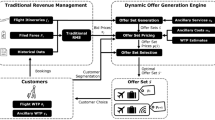Abstract
In the airline industry’s very competitive landscape, being traveler-centric and offering an adapted set of products and services for different customer segments is crucial for airlines to resist and keep growing. By correctly designing and pricing product offers, airlines will reinforce their travelers’ loyalty and open upsell opportunities and strengthen their competitive position and revenue. This paper presents a new approach to design and optimizing airline offers, aiming to better consider travelers’ needs and preferences and improve airline revenue. The proposed method is based on market research and conjoint analysis techniques, combined with a revenue simulation framework. To better understand travelers, airline historical bookings data are used to cluster them in different segments based on their trip characteristics and booking behavior. In addition to the segmentation, a large sample of several thousands of travelers is surveyed using an adapted questionnaire per segment. The survey required participants to select one option among an assortment of a few products with different features. The data collected are used to build a choice model and evaluate the price elasticity. Travelers’ segments, estimated utilities, and choice modeling combined with the price elasticity and product preference shares are used to design the new product offer. A revenue simulation framework is developed to evaluate the revenue impact of introducing these new products in a competitive landscape. It simulates the flight booking life cycle from the flight’s opening for booking until the day of departure. Several scenarios of demand and willingness to pay are evaluated. Our approach is tested on a mid-size, full-service carrier. It allowed a better understanding of the travelers’ segments and behavior and resulted in a revenue improvement ranging from 1.6 to 4%, depending on the cabin and simulation scenario. Following the obtained results, the study recommendations’ are being implemented in production with an airline partner.






Similar content being viewed by others
References
Bruseberg, Anne, and Deana McDonagh-Philp. 2002. Focus groups to support the industrial/product designer: A review based on current literature and designers’ feedback. Applied Ergonomics 33 (1): 27–38.
Delahaye, Thierry, Rodrigo Acuna-Agost, Nicolas Bondoux, Anh Quan Nguyen, and Mourad Boudia. 2017. Data-driven models for itinerary preferences of air travelers and application for dynamic pricing optimization. Journal of Revenue and Pricing Management 16: 621–639.
Fiig, Thomas, Karl Isler, Craig Hopperstad, and Peter P. Belobaba. 2010. Optimization of mixed fare structures: Theory and applications. Journal of Revenue and Pricing Management 9 (1–2): 152–170.
Gallego, Guillermo, and Garrett J. van Ryzin. 1994. Optimal dynamic pricing of inventories with stochastic demand over finite horizons. Management Science 40 (8): 999–1020.
Gallego, Guillermo, Anran Li, Van-Anh Truong, and Xinshang Wang. 2015. Online resource allocation with customer choice. https://arxiv.org/abs/1511.01837
Green, Paul E., and Vithala R. Rao. 1971. Conjoint measurement for quantifying judgmental data. Journal of Marketing Research 8: 355–363.
Philip, Kotler, and Kevin Lane Keller. 2009. Marketing management, 13th ed. New Jersey: Pearson Prentice Hall.
Levitt, Theodore. Marketing success through differentiation-of anything. 1980. Harvard Business Review. https://hbr.org/1980/01/marketing-success-through-differentiation-of-anything.
Lheritier, Alix, Michael Bocamazo, Thierry Delahaye, and Rodrigo Acuna-Agost. 2019. Airline itinerary choice modeling using machine learning. Journal of Choice Modelling 31: 198–209.
MacQueen, James. 1967. Some methods for classification and analysis of multivariate observations. In Proceedings of the fifth Berkeley symposium on mathematical statistics and probability, vol. 1, 281–297. Oakland, CA, USA.
McFadden, Daniel. 1973. Conditional logit analysis of qualitative choice behavior. California: Institute of Urban and Regional Development, University of California.
Orme, Bryan K. 2014. Getting started with conjoint analysis: Strategies for product design and pricing research. Manhattan Beach: Research Publisher.
Peppers, Don and Martha Rogers. 2005. Customers don't grow on trees. Fast Company. https://www.fastcompany.com/53030/customers-dont-grow-trees.
Rao, Vithala R. 2014. Applied conjoint analysis. Berlin: Springer.
Ratliff, Richard, and Guillermo Gallego. 2013. Estimating sales and profitability impacts of airline branded- fares product design and pricing decisions using customer choice models. Journal of Revenue and Pricing Management 12: 509–523.
Talluri, Kalyan, and Garrett Van Ryzin. 2004. Revenue management under a general discrete choice model of consumer behavior. Management Science 50 (1): 15–33.
Thorndike, Robert L. 1953. Who belongs in the family? Psychometrika 18: 267–276.
Wind, Jerry, Paul E. Green, Douglas Shifflet, and Marsha Scarbrough. 1989. Courtyard by marriott: Designing a hotel facility with consumer-based marketing models. Interfaces 19: 25–47. https://doi.org/10.1287/inte.19.1.25.
Wittman, Michael D., and Peter P. Belobaba. 2017. Personalization in airline revenue management—heuristics for real-time adjustment of availability and fares. Journal of Revenue and Pricing Management 16 (4): 376–396.
Author information
Authors and Affiliations
Corresponding author
Additional information
Publisher's Note
Springer Nature remains neutral with regard to jurisdictional claims in published maps and institutional affiliations.
Rights and permissions
About this article
Cite this article
Boudia, M., Mohamed, S., Bondoux, N. et al. Traveler centric airline offer design and optimization. J Revenue Pricing Manag 20, 634–645 (2021). https://doi.org/10.1057/s41272-021-00346-7
Received:
Accepted:
Published:
Issue Date:
DOI: https://doi.org/10.1057/s41272-021-00346-7




